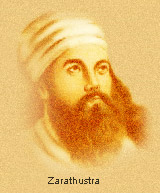 “Shri Mataji has described Zarathustra (Zoroaster) as one of the 10 Adi Gurus looking after our void, situated on our left side. Many do not know, that Zarathustra incarnated in Persia much before others and His vision of the world has left some traces on Judaism and Christianity which came much later. Today in terms of numbers Zoroastrians are very few in the world, but the rich heritage of human spiritual thought that Zarathustra has left behind is still very appropriate and typical to today’s world. The basic teachings of Zarathustra give an essence of his revelations, Zarathustra’s vision of the world and his heritage to humanity in the form of revealed religion known as Zorashtrianism.
“Shri Mataji has described Zarathustra (Zoroaster) as one of the 10 Adi Gurus looking after our void, situated on our left side. Many do not know, that Zarathustra incarnated in Persia much before others and His vision of the world has left some traces on Judaism and Christianity which came much later. Today in terms of numbers Zoroastrians are very few in the world, but the rich heritage of human spiritual thought that Zarathustra has left behind is still very appropriate and typical to today’s world. The basic teachings of Zarathustra give an essence of his revelations, Zarathustra’s vision of the world and his heritage to humanity in the form of revealed religion known as Zorashtrianism.
“Like many of the great prophets Zarathustra established the one God, whom he called Ahura Mazda, as the basis of belief. After a period of meditation in the wilderness he realised the singular Self (the ‘One without another’ described in the Upanishads) and wanted people to turn their attention away from distracting multiplicity and towards that singular Self. However, this Monad was not a dreary monolith; it was more like a multi-faceted jewel. In order to bring about the creation and maintenance of the world it gave forth six divine beings (known as Amesha Spentas) which, including itself made up a sevenfold creation. The old Iranian deities, which are archetypes, found all over the ancient polytheistic world from Egypt to India were not abandoned entirely but were identified with these seven angelic beings or Immortals…
“Zoroastrian refugees arrived in the Gujarat region of India in the 8th century AD, and it is not surprising that in the relatively tolerant atmosphere of the Hindu culture into which they were received, some Parsi thinkers looked for, and found, similarities between their cosmology and that of the Hindus. The Seven Amesh Spentas described by Zoroaster in his Gathas have been compared by some Indian Parsis, with the Seven Chakras (subtle centres) of yoga tradition, each of which also represents an aspect of Creation…
“In the Zoroastrian system Wisdom is necessary for Knowledge, Knowledge is necessary for Harmony with nature, Harmony with nature leads to Righteousness and Love, which leads to Perfection, which leads to Immortality and thence to self-realisation. Zarathustra described the seven qualities of the One, not merely to make a compromise with the old religion of many deities. He wanted his followers to strive to awaken these qualities in themselves. His concept of emanations from the Godhead formed the foundation of Gnostic Christianity and influenced the development of the mystical aspect of Judaism – the Kabbalah.
“Benevolence towards others is the essence of the prophet’s teaching, encapsulated in the words: ‘Good Thoughts, Good Words, Good Deeds’. Many subsequent prophets have imparted similar teachings and it is easy to underestimate the revolutionary nature of Zarathustra’s ideas; one of the most important being the concept of free will. Followers of Monotheistic religions owe much to Zarathustra and could benefit from his concept of a single God with multiple creative aspects, both masculine and feminine. In yoga these are conceived of as seven flower-like spiritual centres, each with its abiding deity or aspect of the Self, on a single Tree of Life.”
Excerpts from Nirmal Fragrance. Pune, India: Nirmal Infosystems & Technologies, 2005.
(Photograph: ajna.com)